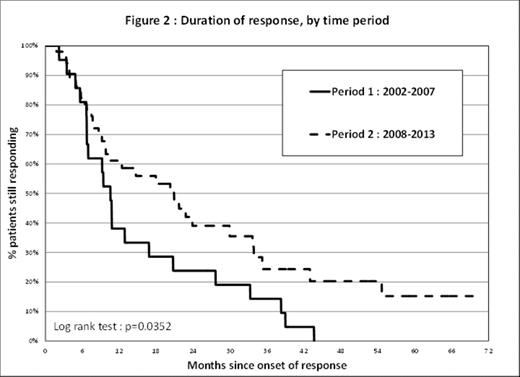Abstract
Background: Treatment of relapsed or refractory (R/R) chronic lymphocytic leukemia (CLL) remains challenging. Major progress has been achieved with new agents such as ibrutinib and idelalisib. However relapses still occur with these agents or the treatment has to be withdrawn (Byrd et al, Blood 2015). Several new drugs have been or are currently tested in pivotal, non-controlled phase 2 trials on R/R CLL patients, with the majority of patients on 2nd line therapy following chemoimmunotherapy. Thus, reliable and matching historical data are required for comparison. We have previously reported on the outcome of heavily pretreated refractory patients (Eketorp Sylvan et al, Leuk Lymphoma 2014). The aim of the this study was to specifically investigate the outcome of 2nd line treatment prior to the access of small molecule-based treatment options, in consecutive patients from a well-defined geographical region, where almost complete follow-up exists and external referrals are minimal.
Methods: Patients diagnosed with CLL were identified from the Cancer Registry in Stockholm (Nov 2002- Dec 2013) and patient files were reviewed individually to identify R/R patients. Efficacy and toxicity of 2nd line and later salvage therapies were recorded as well as long term follow-up. Patients were also grouped into treated in the early (Nov 2002-2007) and late time period (2008-2013) and compared regarding outcome. A multivariate cox proportional hazards model was perform to explore risk factors for outcome.
Results: Chart review of 979 patients identified 148 consecutive, non-referred patients with R/R CLL undergoing various types of 2nd line salvage therapy. Median age was 73 years and 53% had Binet stage C. Del17p testing was available in 46% of patients of which 20.6% had del17p. Most frequently initiated treatments in 2nd line were chlorambucil (27.7%), FC (23.6%) and FCR (13.5%). The overall response rate (ORR) was 48.6% (3.4% CR).
Median overall-survival (OS) from start of second line therapy was 37.9 months. Shorter OS was significantly associated with ECOG higher than 0, male sex, and age > 80 years. There was no difference in OS, PFS or ORR between those treated in the first vs the second time period of this study, despite that 2nd line use of chlorambucil decreased from 39% to 23% and use of FCR or BR increased from 0% to 26% from 2002-2007 to 2008-2013. However, median duration of response was significantly longer during the later time period (20.9 vs 10.3 months, p=0.035).
During treatment, 50.7% of patients were hospitalized and 32.4% of patients experienced grade III-IV infections. Other AEs ≥ grade 3 occurred in 10.1% and 7.4% had bleeding events. Grade 3/4 hematological toxicity, according to IWCLL-criteria, occurred in 0.7%/0.7% (Hb), 11.5%/8.8% (platelets) and 16.9%/36.5% (neutrophils). Toxicity was similar in both time periods.
Conclusion: Our study describes the outcome of 2nd line treatment in R/R CLL in consecutive patients from a geographically well defined region with almost complete follow-up and without influence on the results from external referrals. Almost no improvement was observed in the outcome of 2nd line treatment during the 10 year period. Such real-world results may be used for comparison with data obtained in non-controlled phase 2 trials on new orphan drugs.
Keywords: Chronic lymphocytic leukemia, Relapsed, Refractory, Clinical outcome
Asklid:Janssen Cilag: Research Funding. Mattsson:Janssen Cilag: Research Funding. Björgvinsson:Janssen Cilag: Research Funding. Winqvist:Janssen Cilag: Research Funding. Eketorp Sylvan:Janssen Cilag: Research Funding. Søltoft:Janssen Cilag: Employment. Repits:Janssen Cilag: Employment. Diels:Janssen: Employment. Österborg:Janssen Cilag: Research Funding. Hansson:Jansse Cilag: Research Funding.
Author notes
Asterisk with author names denotes non-ASH members.



This feature is available to Subscribers Only
Sign In or Create an Account Close Modal